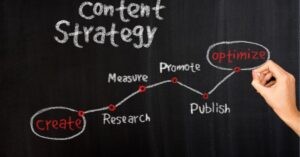Content marketing often feels overwhelming, with marketers pressured to produce endless fresh ideas daily. The content waterfall strategy offers an efficient solution by transforming one core piece of content into multiple engaging formats, maximizing reach and minimizing stress.
In this guide, you’ll discover practical steps to easily implement a successful content waterfall strategy, complete with actionable tips, common pitfalls to avoid, and specific metrics to measure your results.
What is a Content Waterfall Strategy?
A content waterfall strategy involves creating one comprehensive piece of content and strategically dividing it into multiple smaller formats tailored for various platforms.
This method helps marketers maximize the impact and lifespan of their content without continuously producing new topics. By leveraging this cascading technique, companies efficiently address diverse audience preferences while reinforcing key messages across different channels.
Instead of spending resources on generating unique content daily, marketers repurpose a single high-value piece, such as a detailed blog post or a webinar, into multiple engaging formats.
The content is then distributed through appropriate platforms like social media posts, infographics, video clips, newsletters, and podcasts. This process increases visibility, enhances engagement, and improves overall marketing efficiency through smart recycling of existing resources.
Key Features:
- Starts with a comprehensive core content piece, designed for easy segmentation into smaller, relevant formats.
- Tailored content distribution, optimized specifically for the strengths and audience expectations of each platform.
How To Utilize Waterfall Marketing Strategy: Step-by-Step Guide
Implementing a waterfall marketing strategy does not have to be complicated or overwhelming. With clear, actionable steps, you can effortlessly transform one content idea into numerous engaging pieces, each tailored to your target audience.
Step 1: Identify Your Pillar Content
The first critical step involves selecting robust, comprehensive pillar content that provides substantial value to your audience. Ideal pillar content can be a detailed blog post, a video tutorial, a webinar, or a podcast episode offering deep insights into a specific topic.
Ensure the chosen content addresses common pain points or frequently asked questions your audience genuinely cares about. Your pillar content must be versatile enough to be broken down into smaller, digestible pieces for different channels.
It is essential to evaluate the content’s potential by asking yourself if it contains enough insights, data, or compelling narratives to create multiple meaningful spin-offs. Effective pillar content acts as the anchor, making subsequent content creation seamless.
Step 2: Strategically Repurpose Your Content
After determining your pillar piece, the next step involves strategically repurposing content segments across multiple platforms.
For instance, a comprehensive blog can be segmented into shorter articles, LinkedIn posts, Twitter threads, or visually appealing infographics. Likewise, a single webinar recording can produce insightful video snippets, podcasts, quotes, or quick social media tips.
When repurposing content, focus on adapting each piece specifically for the intended platform’s format, tone, and audience expectations.
Effective adaptation ensures each content fragment feels tailored and relevant rather than redundant or overly repetitive. Proper repurposing not only saves valuable time but also consistently amplifies your brand’s messaging.
Example Repurposing Formats:
- Long-form blog → Infographic, LinkedIn articles, Twitter threads
- Webinar → Short video clips, audio podcasts, visual quote graphics
Step 3: Plan and Schedule Your Content Distribution
Planning your content distribution calendar ahead of time is crucial for successfully executing a waterfall strategy. Utilize content scheduling tools such as Buffer, Later, or HubSpot to automate distribution efficiently and consistently across channels.
Scheduling content ahead allows you to maintain a steady online presence while freeing up resources to focus on analytics and content strategy adjustments.
Ensure your content rollout follows a logical, purposeful timeline, initially releasing your pillar content followed by the segmented pieces gradually to sustain audience interest over time.
Thoughtfully spacing out content distribution reinforces your messaging, maintaining engagement levels without overwhelming your audience. This disciplined approach streamlines your content marketing efforts, resulting in consistent growth and improved outcomes.
Recommended Scheduling Steps:
- Select optimal posting times based on platform analytics.
- Leverage automation tools for consistency and efficiency.
Step 4: Engage and Interact with Your Audience
Actively engaging with your audience by responding to comments, asking for feedback, or initiating discussions significantly improves your content’s effectiveness. Prompt interaction signals authenticity, builds trust, and makes your followers feel valued.
Regular interaction increases visibility and reinforces your reputation as a responsive, attentive brand. Audience engagement should not be limited to reactions alone; it should proactively involve asking insightful questions to spark meaningful dialogue.
Effective engagement ensures your content continues resonating with your target market and aligns with their evolving needs and expectations. This two-way communication fosters long-term relationships and brand loyalty.
Step 5: Analyze and Optimize Your Results
Tracking and measuring the performance of your content waterfall strategy is essential to ensure continuous improvement.
Utilize analytics tools such as Google Analytics, SEMrush, or platform-specific insights to monitor metrics like engagement, traffic, and conversions. These insights help you determine which content pieces perform best and where adjustments are necessary.
Consistently analyzing your data empowers informed decisions, allowing refinement of future content strategies based on clear evidence rather than guesswork.
Adjust your content choices, distribution channels, and formats based on the outcomes to continually elevate performance. This data-driven approach ensures your waterfall marketing strategy remains efficient, relevant, and successful.
Step 6: Update and Refresh Existing Content
Regularly updating and refreshing existing pillar and repurposed content ensures your marketing materials stay relevant and accurate over time.
Evaluate content periodically, checking for outdated information, broken links, or new industry developments worth mentioning. Updates not only maintain high-quality content but also positively influence SEO rankings.
Refreshing content includes enhancing previously successful posts with additional value, such as new statistics, insights, or improved visuals. Continuous improvement encourages repeat visits, boosting user engagement and long-term audience retention.
Prioritizing updates keeps your content waterfall strategy sustainable, evergreen, and highly effective.
Real-Life Content Waterfall Wins: 4 Brands Doing It Right
HubSpot: Mastering the Blog-to-Social Media Cascade
HubSpot successfully transforms extensive blog articles into multiple high-performing LinkedIn posts, Twitter threads, and infographics.
One detailed guide on email marketing generated numerous smaller pieces, significantly increasing their social media engagement metrics. This approach continuously positions HubSpot as an industry leader while maximizing content ROI.
Gary Vaynerchuk: The “Content Pyramid” Method
Entrepreneur Gary Vaynerchuk popularized cascading content by creating pillar content such as keynote speeches or long-form videos, then repurposing them into micro-content like Instagram clips, quotes, and podcasts.
His method amplified his visibility exponentially without frequent new content production. This tactic substantially grew his personal brand and audience across multiple channels.
Moz: Whiteboard Friday’s Multi-channel Success
Moz leverages their weekly “Whiteboard Friday” video series as cornerstone content, subsequently turning it into engaging blog posts, newsletter summaries, and social media visuals.
This content recycling strategy significantly boosted Moz’s website traffic and audience loyalty. Whiteboard Friday content continues to consistently drive valuable SEO rankings and high user engagement.
Neil Patel: One Webinar, Endless Engagement
Neil Patel routinely repurposes high-value webinars into bite-sized YouTube videos, blog posts, email content, and social media tips. A single webinar often generates weeks’ worth of strategically distributed content, creating substantial visibility with minimal extra effort. This smart repurposing delivers ongoing audience growth and impressive brand authority.
Tools and Resources to Streamline Your Waterfall Content Strategy
Implementing a content waterfall strategy becomes even easier when using the right tools. These three essential resources will simplify your workflow, save valuable time, and enhance your overall content effectiveness.
Buffer: Automated Scheduling Made Easy
Buffer streamlines content scheduling across platforms such as Instagram, LinkedIn, Twitter, and Facebook, enabling consistent and timely posting without manual effort. Its intuitive dashboard makes content management accessible and efficient, ideal for organizing cascading content.
Key Features:
- Automatic posting at optimal audience engagement times.
- Detailed analytics to monitor post performance.
Canva: Effortless Visual Content Creation
Canva allows marketers to easily design eye-catching graphics, infographics, and social media visuals from repurposed content, even without design expertise. It provides a vast selection of ready-to-use templates tailored to each social media platform, enabling quick and professional results.
Key Features:
- Platform-specific templates for consistent branding.
- Drag-and-drop interface for rapid content production.
Airtable: Centralized Content Planning and Collaboration
Airtable combines spreadsheet functionality with powerful database tools, enabling seamless planning, tracking, and collaboration throughout your waterfall content process. Its flexible setup simplifies content calendars, status updates, and team coordination, ensuring efficiency at every stage.
Key Features:
- Customizable content calendars for managing repurposed assets.
- Collaborative workspace facilitating real-time team updates and approvals.
Benefits of Waterfall Marketing Strategy in Businesses
Implementing a waterfall marketing strategy delivers significant advantages for businesses aiming to enhance content efficiency and maximize their resources. By using this approach, brands experience tangible benefits that streamline marketing efforts and amplify results.
Improved Content Efficiency and Productivity
The waterfall marketing strategy drastically reduces the need to constantly develop new, original content from scratch. Instead, businesses maximize the productivity of each content piece by strategically repurposing it across multiple formats and platforms.
This approach saves time and allows marketers to concentrate on strategic planning and audience engagement.
Increased Audience Reach and Engagement
By distributing content strategically across multiple channels, businesses effectively capture a broader and more diverse audience. Each repurposed content piece targets specific audience preferences, formats, and consumption habits, increasing overall engagement.
As a result, brands consistently stay top-of-mind with their audiences, encouraging stronger relationships and loyalty.
Enhanced Consistency and Brand Recognition
Using a waterfall content strategy enables brands to deliver consistent messaging across all platforms. Consistent and repeated messaging helps reinforce brand identity, making it more recognizable and memorable among target audiences. Ultimately, this consistency fosters trust and positions the brand as a reliable authority within its industry.
Cost-Effective Marketing Solution
Waterfall marketing reduces production costs by significantly decreasing the demand for fresh, original content development. Repurposing existing material extends the value of content investments, maximizing returns without substantial additional expenditure.
Businesses can redirect resources toward higher-impact marketing activities or other strategic initiatives.
Greater Content Lifespan and Evergreen Value
A major benefit of the waterfall approach is the prolonged lifespan it grants to content by creating evergreen, relevant pieces across multiple formats. Valuable, informative pillar content continues generating traffic, engagement, and conversions long after initial publication.
Businesses gain lasting returns from a single investment, optimizing long-term marketing effectiveness.
Simplified Performance Measurement and Analytics
Implementing a waterfall strategy simplifies the process of tracking and measuring content performance. Businesses gain clearer insights into which formats and platforms deliver optimal results, enabling better-informed strategic decisions.
This transparency helps marketers refine future strategies, enhancing overall content marketing outcomes.
Final Thoughts: Master Your Marketing with a Content Waterfall Strategy
A content waterfall strategy allows marketers and businesses to maximize efficiency by converting one high-quality pillar content into numerous engaging pieces, driving audience growth without constant content creation stress.
Leveraging strategic repurposing, automation tools, and consistent analytics helps sustain long-term marketing success, brand recognition, and audience loyalty. Adopting this practical approach positions your business for continuous, impactful marketing outcomes while saving valuable resources.
Frequently Asked Questions
How often should businesses create new pillar content?
Businesses should ideally produce new pillar content monthly or quarterly, depending on resources and goals. Regularly scheduled pillar content maintains audience interest, provides fresh repurposing opportunities, and ensures consistent relevance without overwhelming internal teams or target audiences.
Can small businesses effectively implement a content waterfall strategy?
Small businesses can successfully implement a waterfall strategy by carefully selecting valuable content and strategically repurposing it. Focusing on fewer platforms initially, prioritizing audience engagement, and utilizing free or low-cost tools helps small brands optimize their limited resources effectively.
What types of content typically perform best for repurposing?
Content with clear, actionable insights or extensive research, such as comprehensive guides, webinars, or data-driven case studies, performs best. These formats naturally split into smaller pieces, allowing marketers to easily adapt and distribute them across various channels to maximize impact.
Related:
- A Content Strategy That’s Effective Has All These Things
- Evergreen Content: How To Achieve Timeless Results
- 8 Ways to Create Content Faster

We empower people to succeed through information and essential services. Do you need help with something? Contact Us.
Want a heads-up once a week whenever a new article drops?







